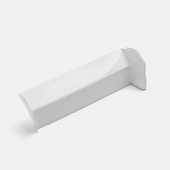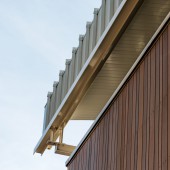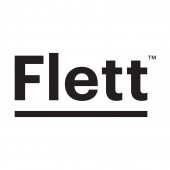The Flett Roof Flashing by Scott Flett |
Home > Winners > #141650 |
 |
|
||||
| DESIGN DETAILS | |||||
| DESIGN NAME: The Flett PRIMARY FUNCTION: Roof Flashing INSPIRATION: Traditional Metal Roofing or Architectural Cladding continues to be an enduring method of cladding throughout the world. One of the design challenges of using architectural cladding is how to resolve junctions. The issue is that each standing seam panel is asymmetrical and must be installed in sequence. There is currently no product on the market for architectural cladding that facilitates a quick change in direction. This has been done by hand for hundreds of years. The design challenge is to create a durable and aesthetically pleasing flashing suitable for standing seam cladding that is quick and easy to install. UNIQUE PROPERTIES / PROJECT DESCRIPTION: The Flett Flashing is the world’s first 3D printed roof flashing. 3D printing allows the flashing to perfectly match any specified roofing profile and colour and permits junctions between roofing sheets of different pitches to be installed without difficulty. This invention makes architectural cladding quicker, easier and cheaper to install and represents a step change for the roofing and cladding industry. OPERATION / FLOW / INTERACTION: I hope to inspire the world to improve roof design. I am the first architect in the world to have designed a 3d printed roof flashing. I am also the first builder in the world to have manufactured and installed a 3d printed roof flashing. I have shown that architects can have more design options and builders have more solutions. I have demonstrated that 3d printing belongs in the collective site toolbox. Australia, and the world, has a problem with leaking roofs. Difficult junctions and poor roof design are the leading causes of roof leaks. My design addresses this problem. The Flett Flashing can be tailored to suit multiple profiles, responding to design requirements of its local environment, enabling application to a wide range of locations. PROJECT DURATION AND LOCATION: The project started on January 2017 and is ongoing. The Flett Flashing has been installed on a house that I built in Hobart, Tasmania. The Flett flashing is a derivative of 4 years of relentless design iterations and constant printing. The form is the result of over 1000 days of improvement. I am continuing the commercialisation of this invention in Sydney at the UNSW start up hub: 'Founders'. FITS BEST INTO CATEGORY: Building Materials and Construction Components Design |
PRODUCTION / REALIZATION TECHNOLOGY: The Flett flashing is produced with 3d printing or additive forming. I designed a mold that under-laps the sectional profile of standing seam cladding sheet, permits any change in direction and then overlaps the sectional profile of an subsequent sheet. I developed an additive manufacturing process that consistently produces a robust product that is thermally stable, UV stable, nontoxic and color matched to the roofing sheet. I developed an installation method that allows the sheets to be installed in sequence and quickly. The installed product looks clean, simple and aesthetically consistent. SPECIFICATIONS / TECHNICAL PROPERTIES: 265mm x 50mm x 100mm 2mm thick ASA plastic, color matched to roofing profile. TAGS: roof, flashing, roof flashing, 3d print, 3d printing, additive forming RESEARCH ABSTRACT: The Flett Flashing aspires to catalyse a global rethink of roof design. The world has only modestly changed the way it designs roofs since the invention of corrugated iron in 1829. Roofs are at the very essence of shelter. Our shelter, and built environment as a whole, needs to respond to its environment. This is particularly applicable in Australia, where the homes are still often styled on European and American homes. Australia deserves to have a roof design that suits its conditions. The Flett Flashing is this Australian design. It not only gives greater creative options to architects and better solutions for builders but it also responds to our unique environmental challenges, and way of life. Everyone knows someone whose roof has leaked. It is one of the most common building defects and even minor damage causes an immense financial burden. The Flett Flashing aims to prevent this problem. CHALLENGE: Architectural Cladding is installed by specialist trade personnel. This generally requires decades of experience, is time consuming and as a consequent is expensive. This often leads to architectural cladding being priced out of commerciality. With the Flett Flashing, this can be installed by carpenters, builders or other trades without the requirement of a specialist trade. ADDED DATE: 2022-05-28 23:29:45 TEAM MEMBERS (1) : Scott Flett IMAGE CREDITS: Video Credits: Chris Shurman and Charles Whittington Image Credits: Chris Shurman and Mark Lobo PATENTS/COPYRIGHTS: Patented. Patent No 2020314005. Year 2020. Australia Trademark: 2022. Scott Flett Architecture Workshop Flett: Australian Trade Mark Registration No. 2217228 The Flett Flashing: Registered Design 201915882 Australian Patent: 2020314005 PCT/AU2020/050728 |
||||
| Visit the following page to learn more: https://www.flett.com.au | |||||
| AWARD DETAILS | |
 |
The Flett Roof Flashing by Scott Flett is Winner in 3D Printed Forms and Products Design Category, 2022 - 2023.· Read the interview with designer Scott Flett for design The Flett here.· Press Members: Login or Register to request an exclusive interview with Scott Flett. · Click here to register inorder to view the profile and other works by Scott Flett. |
| SOCIAL |
| + Add to Likes / Favorites | Send to My Email | Comment | Testimonials | View Press-Release | Press Kit |
Did you like Scott Flett's 3D Printing Design?
You will most likely enjoy other award winning 3d printing design as well.
Click here to view more Award Winning 3D Printing Design.








